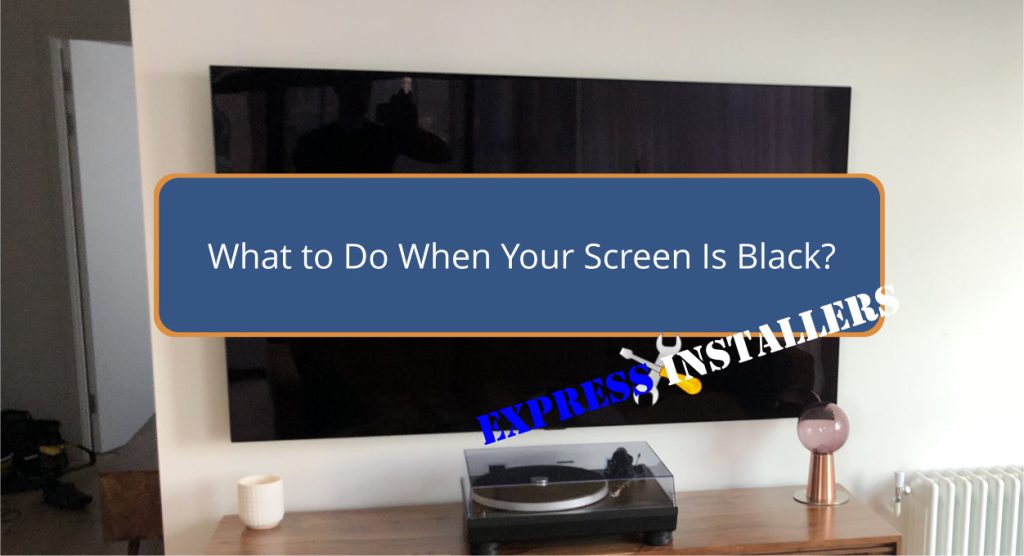
Check the power supply to see if your TV turns on, but the screen is black. Then, confirm the status of the LED indicator light, test the remote’s functionality, and inspect the power cord for damage.
Next, ensure all HDMI and power cords are securely connected and not visibly damaged. Adjust the brightness and contrast settings via the TV menu.
Check for software updates in the settings menu and guarantee a stable internet connection. Finally, shine a flashlight on the screen to spot faint images, indicating a backlight issue.
Follow these steps to uncover potential solutions to your display problem.
To start troubleshooting a black screen, first check if the LED indicator light on your TV is on to confirm it’s receiving power.
If the light isn’t on, test the remote control by replacing its batteries.
Next, confirm the functionality of your surge protector by plugging another device into it.
Ensure the power cord is undamaged; replace it immediately if it’s frayed or worn.
Try connecting the TV to a different outlet to rule out issues with the current outlet.
If the TV still doesn’t power on, inspect your home’s fuse box to ensure no fuses are blown.
Ensure all cable connections, including HDMI and power cords, are securely plugged into the TV and the wall outlet. First, verify that no cables are loose.
Inspect each HDMI and power cord for visible damage or wear. Check that the input source device, such as a cable box or gaming console, is firmly connected to the TV. If any cables seem loose, reinsert and secure them to guarantee a stable connection.
Restart your external devices to troubleshoot signal interruptions. If the screen remains black, use a different HDMI port or a new cable to rule out faulty equipment.
These steps will help identify and resolve connectivity issues causing the black screen.
After ensuring that all cable connections are secure, adjust the TV’s Brightness and Contrast settings to enhance display visibility and troubleshoot the black screen issue.
Navigate to the TV’s settings menu and locate ‘Picture’ or ‘Display’ settings. Increase the Brightness and Contrast levels incrementally, monitoring for any changes on the screen.
Check the current Picture Mode; switch to ‘Standard’ or ‘Custom’ to avoid preset modes that might cause display issues. If the screen remains black, reset the display settings to default.
Avoid selecting incompatible display modes—such as unsupported resolutions—that could result in a black screen. Correcting these settings can often resolve visibility problems and restore your TV’s display functionality.
Updating your TV’s software can systematically resolve software glitches that may be causing the black screen issue. Begin by accessing your TV’s settings menu. Navigate to the ‘Support’ or ‘System’ section, where you’ll find the option for ‘Software Update‘ or ‘Firmware Update.’ Please select it and follow the on-screen prompts to check for and install the latest software version.
Ensure your TV is connected to the internet, as most updates require an online connection. Manufacturers often include detailed instructions in the user manual or on their website. Regularly updating your TV’s software fixes existing bugs and enhances performance and compatibility with connected devices.
Always check for updates to maintain peak functionality and prevent future display problems.
To diagnose backlight issues, start by shining a flashlight on the screen to determine if the picture is faintly visible. If you see a faint image, the backlight is likely burnt out.
Adjust the brightness and contrast settings to see if this resolves the problem. If the screen remains black, you’ll need a backlight replacement. Contact the manufacturer for specific guidance on acquiring and installing a new backlight.
For severe backlight issues, replacing the TV might be a cost-effective solution. Always confirm the TV is unplugged before performing any hardware checks or replacements.
Consider professional assistance to avoid further damage if you’re uncomfortable with such repairs.
First, check the power source and remote control functionality. Verify input connections and select the correct input source. Adjust display settings. Perform a soft reset by unplugging the TV for a minute. Seek professional help if needed.
First, verify the input source and make sure cables are securely connected. Check display settings for brightness and contrast issues. Perform a soft reset by unplugging the TV for 60 seconds. Inspect for any hardware malfunctions.
Check the power connections and make sure the cables are tight enough. Confirm the input source is correct. Adjust the display settings. If the screen remains dark, consider backlight failure or hardware issues and seek professional repair services.
Your TV might have stopped working suddenly due to hardware malfunctions, software glitches, or power supply issues. Start by checking input connections, resetting the TV, and inspecting cables. If the problem remains unresolved, consult professional repair services for further diagnostics.
Check the power supply and inspect all cable connections if your TV turns on but the screen stays black.
Adjust the display settings and update the TV software if needed.
Finally, examine the backlight for potential issues.
By systematically following these steps, you can diagnose and potentially resolve the problem, ensuring your TV functions correctly.
Don’t hesitate to consult the user manual or contact customer support if the issue persists.
Mon-Fri: 24 Hours
Sat: 24 Hours
Sun: 24 Hours